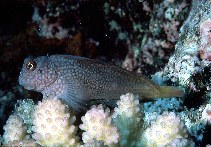| Family: |
Blenniidae (Combtooth blennies), subfamily: Salariinae |
| Max. size: |
10 cm SL (male/unsexed) |
| Environment: |
reef-associated; marine; depth range 0 - 20 m |
| Distribution: |
Indo-Pacific: Kenya south to Mozambique and throughout the Indian Ocean and western central Pacific to the Marshall and Samoan islands. |
| Diagnosis: |
Dorsal spines (total): 11-13; Dorsal soft rays (total): 14-16; Anal spines: 2-2; Anal soft rays: 15-17; Vertebrae: 30-32. Diagnosis: Dorsal fin XII, 15, membrane attached to caudal fin, with deep notch above last spine, first spine slightly higher than second; anal fin II, 16; pectoral rays 15; pelvic fin I, 4; caudal fin procurrent rays 10-14. Vertebrae 10 + 21. LL, without scales and scalelike flaps; LL tubes 1-10 (usually 3-8), canal ends below 7th dorsal ray to caudal-fin base. Lower lip smooth mesially, plicate laterally. Upper lip crenulae 35-52. Gill rakers 23-30. Cephalic pore system simple; no pores at extra interorbital position; a pore present behind nuchal flap on each side. Cirri, supraorbital 7-22, nasal 8-29; nuchal 34-47, in 4 groups, ventralmost group borne on slightly expanded nuchal flap on each side. Head and body dark brown with scarlet reticulum anteriorly which becomes spots and wavy lines posteriorly; iris with yellow-ringed pupil. Gilbert Island males are darker; pigmentation on fins brown instead of scarlet; iris are almost entirely yellow (Ref. 529). Large individuals are dark green to black with red spots on the head and red spots to vertical streaks on the sides (Ref. 1602). |
| Biology: |
Found solitary or forms small groups in the upper edge of seaward reef slopes, less than 10 m, but may be found up to 20 m deep (Ref. 90102). Adults inhabit coastal reef flats with rich coral and algae habitats (Ref. 48636); also on rocky and coralline structures (Ref. 529); among Acropora and Pocillopora corals of surf-swept algal ridge. Oviparous. Eggs are demersal and adhesive (Ref. 205), and are attached to the substrate via a filamentous, adhesive pad or pedestal (Ref. 94114). Larvae are planktonic, often found in shallow, coastal waters (Ref. 94114). |
| IUCN Red List Status: |
Least Concern (LC); Date assessed: 24 March 2009 Ref. (130435)
|
| Threat to humans: |
harmless |
Source and more info: www.fishbase.org. For personal, classroom, and other internal use only. Not for publication.
